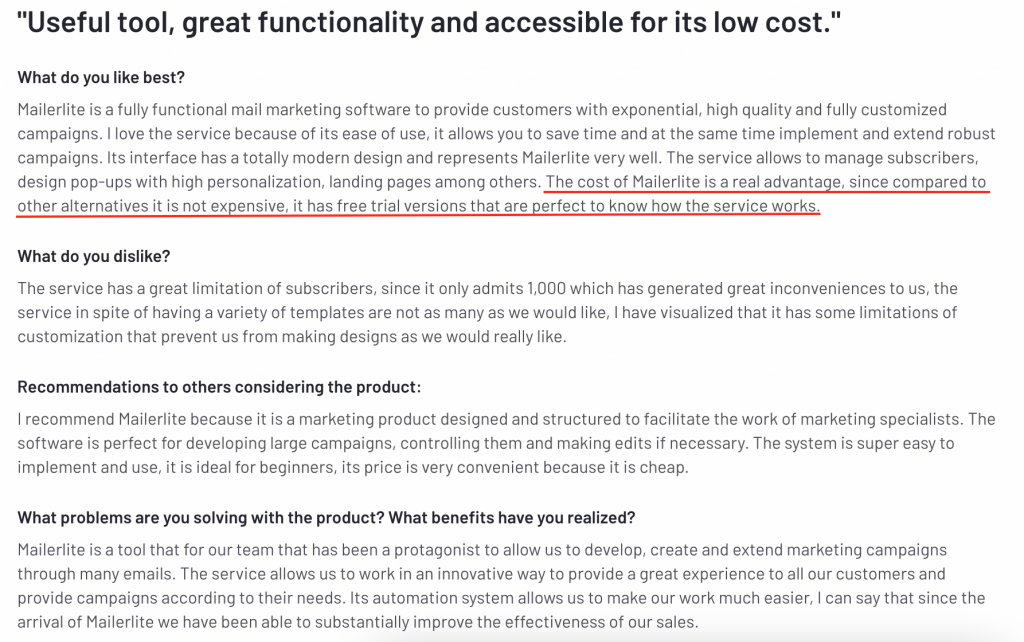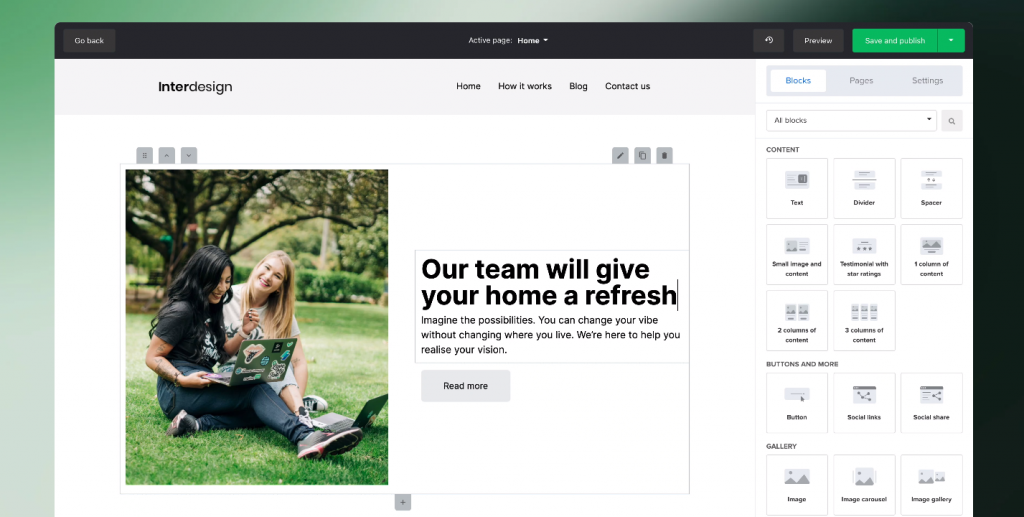MailerLite vs Mailchimp: Complete Guide for Email Marketers
Email marketing is an important channel used by many digital marketing experts.
No matter if you’re just getting started with this strategy or you are already doing it but considering changing your current provider, our comparison is a great place for you as we will discuss two prominent tools – MailerLite and Mailchimp.
What is MailerLite?
MailerLite is a marketing automation platform that includes email marketing features, a website builder, and a subscriber management interface.

While there are many email marketing tools out there that try to cover multiple marketing channels (e.g., SendPulse with its Automation 360), Mailerlite has stuck to email marketing and focused on deepening its functionalities and capabilities in that channel.
With our first tool in question introduced, let us move on to its counterpart – Mailchimp, and see what it has in store.
What is Mailchimp?
Mailchimp is an all-in-one marketing SaaS service with a focus on contract management best practices and data analysis that lets its users manage communication with their clients.

Mailchimp is a multi-channel marketing automation platform. It means that you can create both email, social media, and ad campaigns in this tool.
As we have introduced our second contestant, too, it is time to identify the central aspect where these two SaaS services differ from each other.
What is the Difference Between MailerLite and Mailchimp?
The main difference between MailerLite and Mailchimp is in the types and number of marketing channels they cover.
Mailchimp positions itself as an all-in-one marketing product by letting its users create digital marketing campaigns, including social media posts, ads, and emails.
Unlike Mailchimp’s strategy of covering several marketing channels, MailerLite has built its expertise in email marketing specifically and covers a wide variety of features related to it.
As we are now familiar with our tools, let’s look at their pros and cons.
MailerLite Advantages and Disadvantages
Like any SaaS software out there, MailerLite has both perks and pitfalls to it. Our curated list includes the most prevalent ones based on the opinions of MailerLite customers.
Advantage #1: Cost-effectiveness
The costs of subscribing to MailerLite are relatively low.
MailerLite users point out that this tool charges a reasonable price while offering many features in their subscription plans (we have one of these positive reviews below):
MailerLite also offers a 30-day free trial, and this is something its users praise too.
Advantage #2: Wide range of features
The term “Lite” in the name should not mislead you and give you the impression that it is a basic tool with limited features.
MailerLite has a considerable list of features (e.g., website builder, form management, email verifier, and more), and it is something that its users appreciate, as clear from the review below:
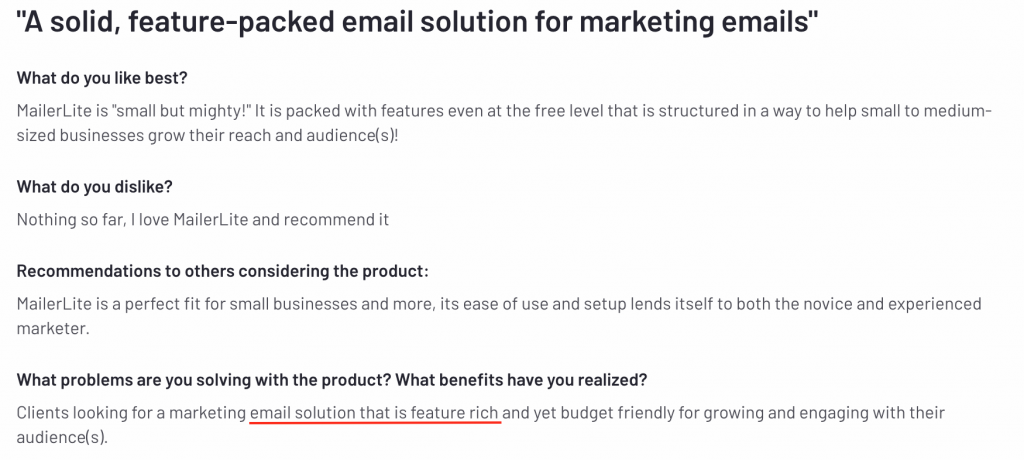
Other than the regular email marketing features mentioned above, MailerLite also has functionality for eCommerce, such as integrated product widgets and others.
Disadvantage #1: Complicated approval process
To protect itself from spammers, MailerLite asks you to submit your website’s address and then verify that it is yours.
But this process can be long and complex for many, including the reviewer below:
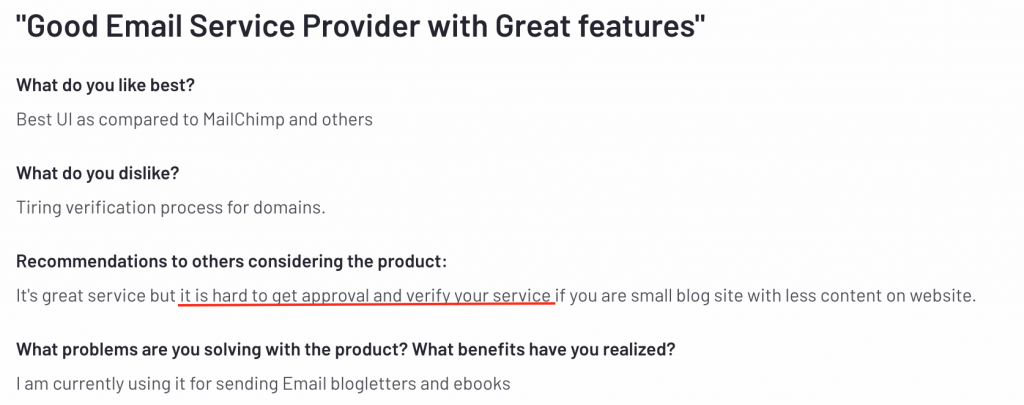
Customers also note that there is a risk that MailerLite will reject your application if you are a small website.
Disadvantage #2: Limited templates
Although MailerLite has a set of email templates, a sizable part of its users consider it not enough and ask MailerLite to add more templates, and the reviewer below is among them:
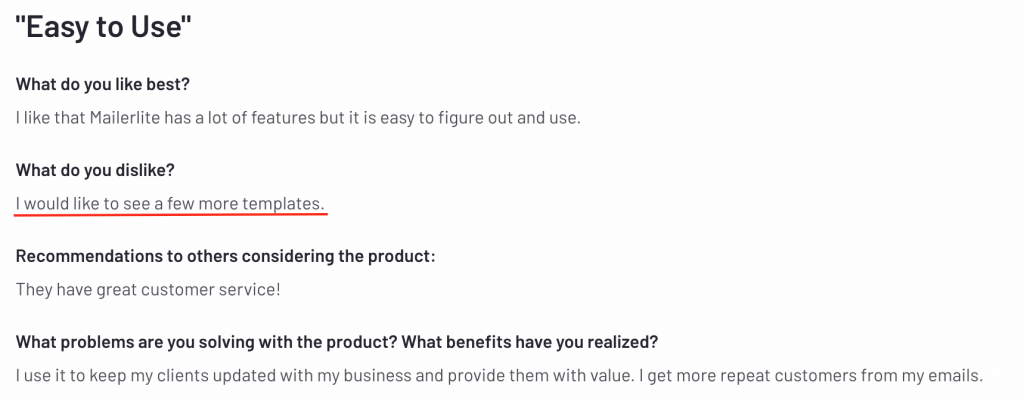
Mainly the requests here are about the variety of templates, not simply the amount, as MailerLite does not cover all email use cases with templates.
To sum up, MailerLite is a low-cost email marketing service with many features, but it lacks an easy approval process and a template variety. Now let’s move on to Mailchimp and its pros and cons.
Mailchimp Advantages and Disadvantages
Mailchimp is a widely tested and reviewed platform with over 10,000 reviews in G2 alone. As with MailerLite, users have praised it on numerous occasions and criticized it too.
Our selection of reviews today includes its most common examples of praises and criticisms (two of each).
Advantage #1: Great variety of integrations
Mailchimp is well-known as a tool with many integrations, plugins, and APIs. Some tools it integrates with include Zendesk, Stripe, Mixpanel, and others.
As one reviewer has noticed (see below), the richness of integration options in Mailchimp makes it easy for the marketing teams to add it to any tool stack and infrastructure:

Other than the integrations, Mailchimp also provides you with a range of developer tools that you can use to interact with Mailchimp programmatically.
Advantage #2: Flexible pricing
Mailchimp offers flexibility in pricing, including several subscription plans and differing prices based on the number of contacts you want to manage.
This is something that reviewers often talk about, too, like in this example:
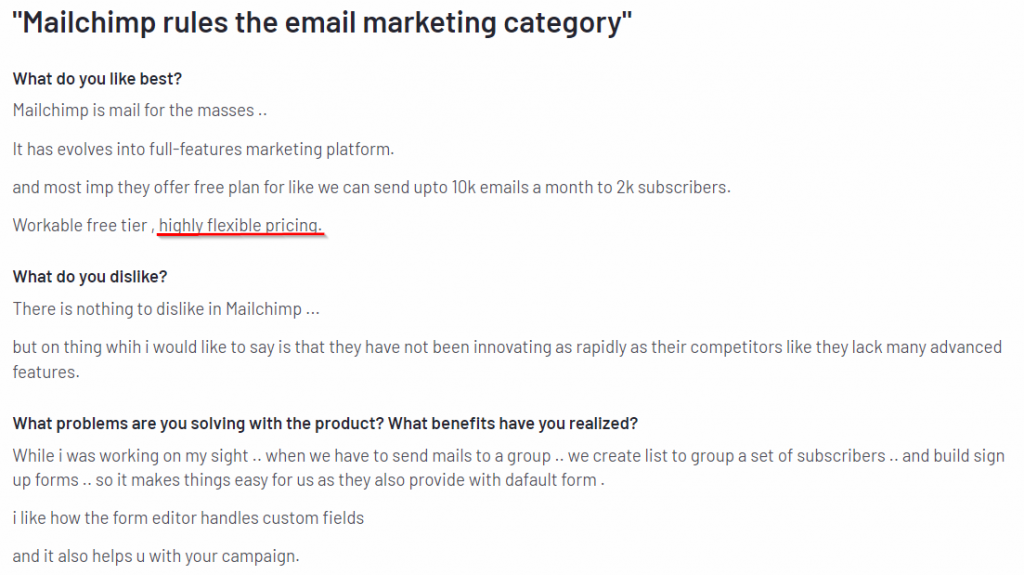
Mailchimp has plans for everyone. For instance, its Essentials plan is great for small teams doing basic email marketing, while the Premium plan is tailored for large agencies and marketing departments. We will cover its pricing plans in more detail further down our comparison guide.
There is also the “pay-as-you-go” plan that provides users with further flexibility, as you are paying for the actual number of uses instead of a fixed monthly price.
Disadvantage #1: Not as user-friendly
That’s right, Mailchimp is rich in features and supports multiple marketing channels, but there is the other side of the coin for that all-in-one approach – Mailchimp’s interface is not intuitive.
Although you will eventually get used to its UI and UX, for beginners, it is a challenge to understand the functionalities of Mailchimp. Some reviewers say that it is the email and landing page editors that are not user-friendly:
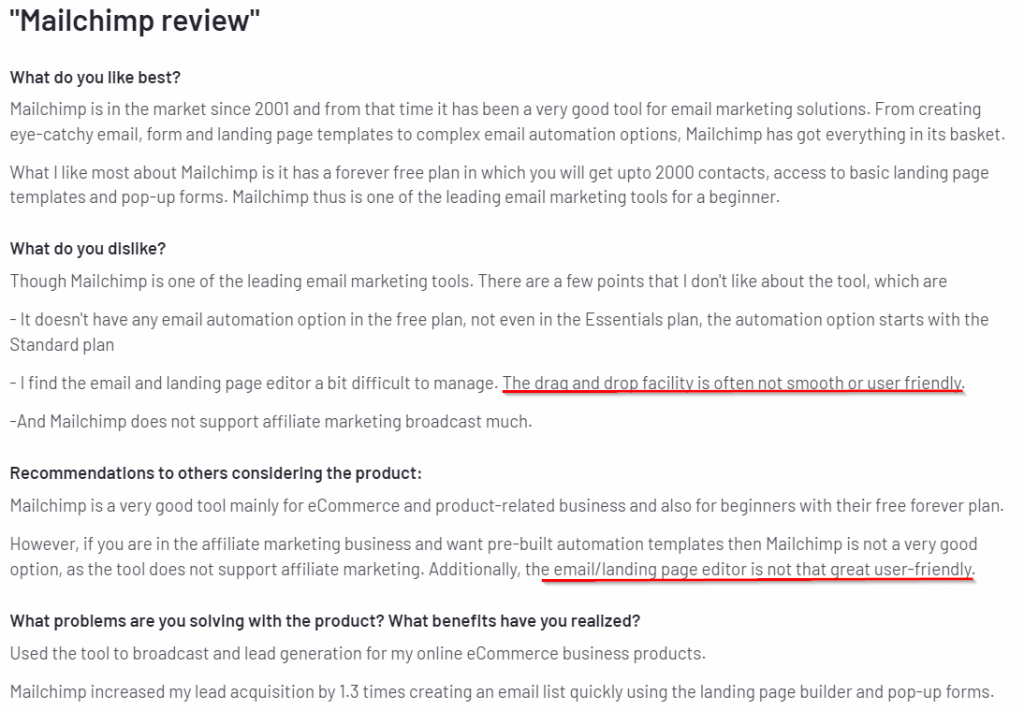
Users have also criticized the drag and drop in Mailchimp because it lacks ease of use.
Disadvantage #2: No email scheduling on free plan
The other disadvantage that many users have found in Mailchimp is its pricing policy.
The scheduling used to be part of the Free subscription plan, but Mailchimp has recently moved it to its paid plans.
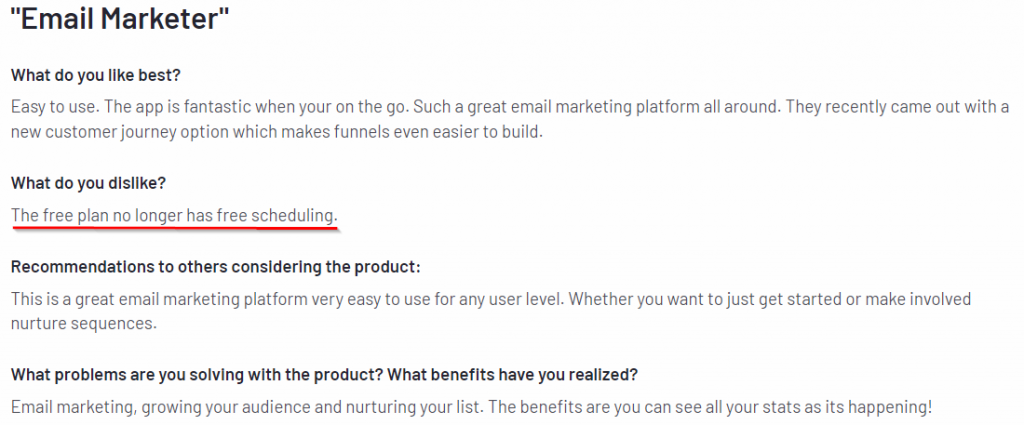
Some Mailchimp users consider this change an inconvenience (including the reviewer above), as they now need to become paid users to access the mail scheduling feature.
To conclude, Mailchimp comes with a flexible pricing model and lots of integrations, but it is challenging for novices to use its interface, and its scheduling feature is not free anymore.
Speaking of features, let us elaborate a bit more on the toolkits that Mailchimp and MailerLite offer to their customers in our first comparison section.
Comparison Point #1: Features
Although Mailchimp and MailerLite have taken different approaches, with one enriching its email marketing capabilities and the other covering multiple channels, there is one thing that we can tell confidently about them – both are rich in features.
But out of the extensive list of capabilities that our services offer, we wanted to highlight the most interesting ones.
MailerLite
MailerLite has built its feature set around email marketing. But it does not limit itself to sending emails only as there are supplementary advanced features like landing page builders, forms, and others.

The list of MailerLite features we have curated for you today includes both its email capabilities and all the additional ones we mentioned.
Feature #1: Email marketing
For a service that focuses on email marketing only, it is natural to see an email campaign builder that includes features such as custom HTML editing, a library with free images, segmentation of the audiences, personalization of messages, and more.
The main campaign builder features a visual email editor with drag-and-drop capabilities.

There are also email automation capabilities, such as auto-resending, RSS campaigns, eCommerce automation, and the analytics suite for monitoring metrics such as open rate, opt-in and unsubscribe rate, deliverability, and bounce rate.
Feature #2: Website builder
As a complementary feature that many marketing experts use along with email marketing, the website builder in MailerLite helps you build landing pages and even entire websites without hiring a developer.
It offers a visual editor with a drag and drop interface, just like email campaigns.
Some of the additional features that come with the website builder include connecting custom domain names, social media sharing buttons, SEO controls, and click maps.
Feature #3: Sign-up forms
The ability to create sign-up forms you can use to gather leads from your website visitors is another important feature many email marketers use.
The sign-up form builder at MailerLite offers these perks:
- GDPR compliance in forms and data storage.
- Embedded forms for adding to your current web pages.
- Landing forms that can live as independent pages.
- Subscription analytics.

The form builder also comes with a variety of responsive templates that look great both on desktops and mobile devices.
Feature #4: Email verifier
Gathering a list of email subscribers where most emails are fake or inactive is one of the nastiest problems that email marketers face.
Thankfully, MailerLite has a special tool for such cases that they call the Email Verifier.
With this tool, you can analyze your email list and filter out those emails that are useless for your marketing needs.
As we can see, MailerLite comes with a comprehensive set of features for email marketers. But our next contestant should not be underestimated too. Let’s move on to Mailchimp and discuss its capabilities.
Mailchimp
Considering the omnichannel approach of Mailchimp, we can expect to see features that are not only about email marketing but also cover CRM, social media, and ads.
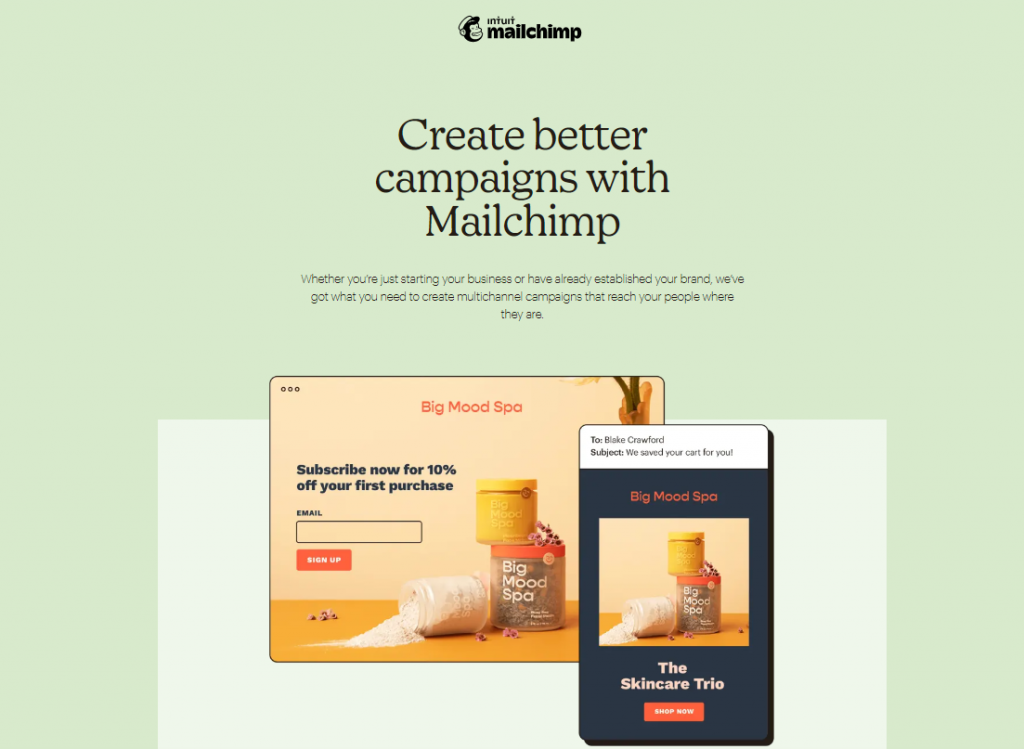
Here is our selection of four prominent Mailchimp features.
Feature #1: Marketing automations
Mailchimp lets you manage email campaigns automatically with its set of automation features that include customer journeys, send time optimization, and others.
The journey workflow builder lets you create a set of actions that will be triggered based on customer behavior, as in the example here:
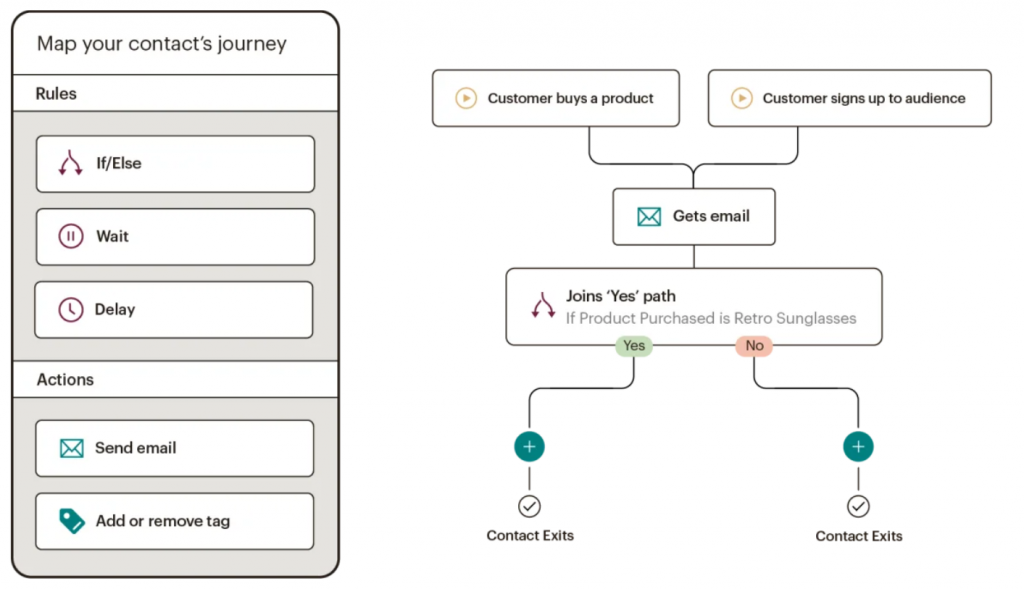
The automated campaigns also integrate well with eCommerce platforms, such as WooCommerce and Shopify.
Feature #2: Content studio
The Content studio at Mailchimp is built for teams to easily manage the creative assets of their campaigns.
The content studio lets teams organize, store, and reuse assets such as images, icons, documents, and more.

You can also connect Content studio to your eCommerce store, and Mailchimp will pull all of your product images from the store and save it in the studio.
Feature #3: Landing pages
Mailchimp, too, offers a landing page builder for its users.
The builder is no-code and lets you create mobile responsive landing pages with a simple drag-and-drop editor and connect them to your domain.

Mailchimp’s landing page builder also has a built-in analytics suite that lets you monitor clicks, conversions, traffic, and other metrics.
Feature #4: Digital ads
Since it is an omnichannel tool, you can manage your advertising with Mailchimp too.
The digital ads suite at Mailchimp lets you configure, run, and manage retargeting ads via social media channels or Google (with remarketing ads).

Among social media channels, Mailchimp supports Facebook and Instagram.
In summary, both email marketing tools have a comprehensive feature set, and your choice boils down to your preference for email-only versus omnichannel.
Coming up next is our second aspect – integration capabilities.
Comparison Point #2: Integrations
Integrations are an increasingly important aspect of choosing a SaaS product as companies are using more and more applications nowadays (around 187 apps per company as of 2022).
This aspect is well covered for our contestants, though, as both Mailchimp and MailerLite can boast with their list of 3rd-party services they can integrate with (including Zapier, Google Analytics, and Gmail for both).
MailerLite
MailerLite has a marketplace for 3rd-party integrations and plugins with over 130 SaaS services it can communicate with.
Here are four that we want to highlight.
Integration #1: Shopify
Shopify is a platform that lets you create and manage eCommerce stores without involving developers. The integration with Shopify includes automatic synchronization of customer data and purchase history with MailerLite.
Integration #2: Stripe
Stripe is a payment processing service that can accept payments in over 100 foreign currencies. With Stripe, you can charge for ebooks, PDFs, paid email newsletters, and online courses in MailerLite emails.
Integration #3: Typeform
Typeform is an online form builder service, and its integration can sync leads from Typeform to Mailerlite, including the responses.
Integration #4: WordPress
WordPress is an open-source CMS platform that powers a third of the web. MailerLite’s integration includes a sign-up form (including pop-up) that you can add to a WordPress website.
To summarize, MailerLite integrates well with the popular 3rd-party tools, but so does Mailchimp, so let’s see what it offers.
Mailchimp
In terms of integrations, Mailchimp also can connect to around 200 tools and services.
Integration #1: QuickBooks
QuickBooks is an online finance management software. With this integration, Mailchimp gets access to users’ invoices and financial data that you can use in marketing campaigns.
Integration #2: Squarespace
Squarespace is a lightweight no-code website builder with eCommerce capabilities. Mailchimp can access the ecommerce data of customers in Squarespace for segmentation and campaign customization.
Integration #3: Shopify
Shopify can also integrate with Mailchimp and share data about products, purchases, and customers.
Integration #4: Firebase
Firebase is Google’s low-code service that many apps use as backend. Mailchimp can pull authentication data from Firebase and make email lists out of them.
In conclusion, both services can integrate with most large SaaS tools, and your choice depends on the tool stack you are using now.
Now let’s conclude our comparison with our last aspect – pricing.
Comparison Point #3: Pricing
Both Mailchimp and MailerLite are operating with the SaaS business model. So you can expect to see several subscription plans with different features and customer support types, e.g., phone support, live chat support, email support, knowledge base, tutorials, FAQs. The prices can also change depending on the number of contacts you manage.
MailerLite
MailerLite has three paid plans with 30-day trials and a free-forever plan.
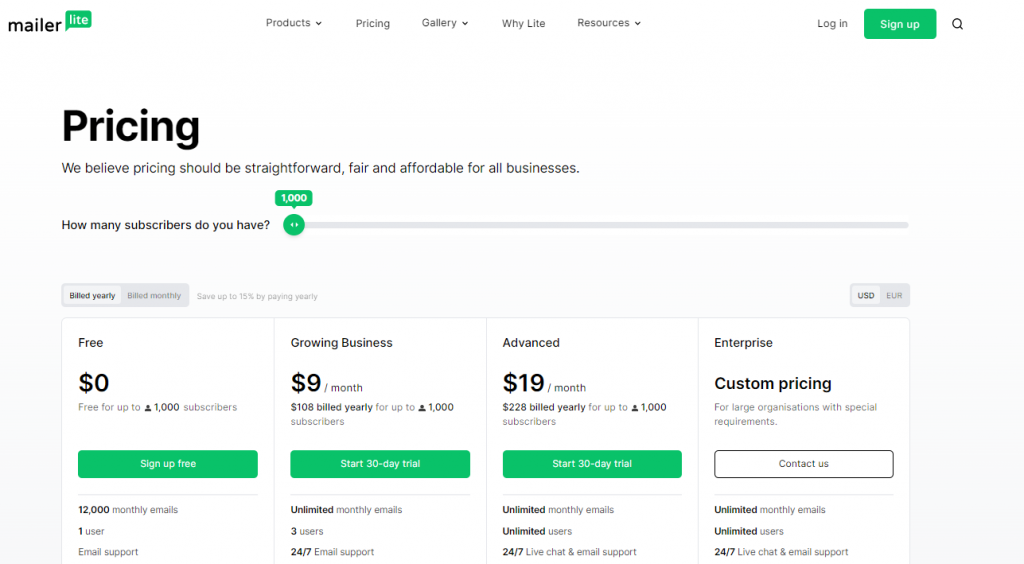
These plans include:
- Free plan with a 12,000 monthly email limit and 1 user access.
- $9/month Growing Business plan with unlimited emails and 3 user seats.
- $19/month Advanced plan with unlimited emails and users.
There is also the Enterprise plan with custom features and pricing.
Mailchimp
Mailchimp pricing includes 3 paid plans with no free trial, a free-forever plan, and an option to pay per usage.

Mailchimp’s plans are:
- Free plan with 10,000 monthly emails and 1,500 contacts.
- $11/month Essentials plan with journey, branding, and A/B testing.
- $17/month Standard plan with send time optimization and dynamic content.
- $299/month Premium plan with unlimited user seats and role-based access.
To sum up, the pricing plans are quite similar too. So check out the features they provide and choose based on your needs.
Now Over to You
Both MailerLite and Mailchimp are great tools for digital marketing. Mailchimp is great when you want to focus on both email and ads, while MailerLite can be a good choice if you prefer to do email marketing only (check out our list of inspirations for this one).
We have also compared Mailchimp to ActiveCampaign and SendGrid, so check them out too.
If you liked our content, we have more of it in our blog.

Sona Kalantaryan is a senior digital marketer with a creative past. Big fan of high cinema and well-optimized landing pages. She authors guides by sharing the best practices and does it the right way!

